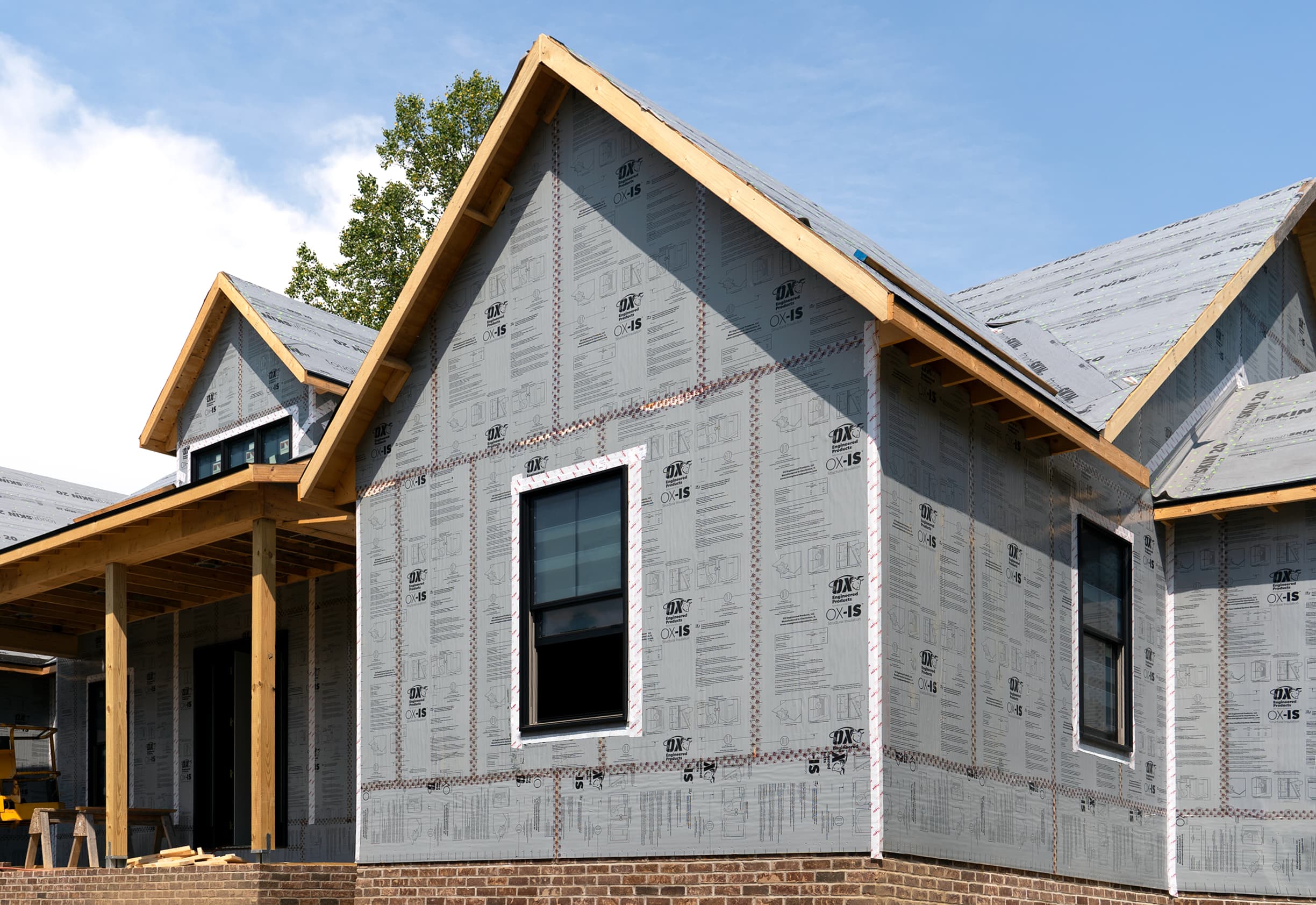CONTACT OX
TO LEARN MORE
Give us a call at 800-345-8881 or fill out the form below
and we’ll get back to you within two business days.

In modern-day construction, meeting the demands of energy efficiency and structural integrity is paramount for any builder. One key innovation in the construction space that was designed specifically to address these needs is continuous insulation. When installed continuously, insulation outboard the studs provides a myriad of benefits for owners and occupants.
Continuous insulation is becoming a go-to choice for modern builders, and those that use it can tout its benefits to prospects and customers to earn more business. With initiatives such as 45L pushing green building practices and overall sustainability across the industry, using energy-efficient building materials is incentivized more than ever before.
What is Continuous Insulation?
Continuous insulation is installed continuously around the exterior walls of a building. Unlike traditional insulation methods that may have gaps and succumb to thermal bridging, continuous insulation provides a seamless thermal barrier, reducing heat transfer and improving energy efficiency.
Many industry professionals refer to continuous insulation as a “big blanket” that surrounds the entire structure. Unlike traditional batt insulation that is split by the stud, there are no spaces or breaks in a continuous insulation installation for thermal energy to pass. Therefore, the material is popularly used in residential, multifamily, and even commercial applications to eliminate thermal loss.
Advantages of Continuous Insulation
Continuous insulation offers several advantages over traditional insulation methods such as fiberglass batts, spray foam, or loose fill. It provides a higher level of thermal performance, helping to reduce heating and cooling costs for owners. When combined with high-performance windows and doors, continuous insulation is the perfect solution for lower HERS scores, landing these homes in the top percentile of energy-efficient homes across the country.
Continuous insulation also improves overall occupant comfort by maintaining more consistent indoor temperatures. This is important in both summer and winter seasons and in any region or climate.
In the summer, continuous insulation is designed to keep that prized conditioned air inside of the building. In the winter, the material can ease the workload of furnaces or other heating appliances in the home by maintaining warmer indoor temperatures for longer periods of time.
Code Compliance for Today’s Builder
Continuous insulation meets the needs of modern builders in several ways when it comes to sustainability and code compliance.
One of the most considerable changes to the International Code Council’s 2021 guidelines are updates to insulation minimum R-values. For instance, in climate zone three (the Carolinas, Georgia, Alabama, and many more), builders of wood frame structures must meet R-values of 19 or 13+3ci or 0+15ci. And in many other regions of the United States, these values jump to R-20.
For builders across the country who are accustomed to using cavity insulation only, supplementing with more efficient continuous insulation solutions can help to maintain compliance with these codes. It also helps eliminate the thermal breaks that are commonplace with cavity-only installations to help homes perform at a higher level.
Continuous Insulation vs. Traditional Insulation
Continuous insulation outperforms traditional insulation materials such as fiberglass, cellulose, and others. It provides a more effective thermal barrier and is much less prone to issues such as settling and moisture retention.
Continuous insulation is often more durable than traditional insulation, and because it is less prone to moisture intrusion and mold growth, it can help extend the lifespan of the building envelope. This is crucial in minimizing the risk of sick building syndrome, which can have adverse effects on the occupants inside.
Finally, one common misconception is that continuous insulation is only suitable for new construction. In reality, continuous insulation can be used in retrofit applications for existing structures that need a boost in thermal performance.
21st-Century Insulation Options
Innovations in insulation have led manufacturers to create integrated structural continuous insulation materials, also called structural insulated panels, or SIPs. These solutions truly cover the gamut when it comes to protection from the elements: air, moisture, thermal, and vapor intrusion.
Not only does insulated sheathing provide a layer of insulation, but it adds in structural support, eliminating the need for builders to buy sheathing separately. For large-scale structures or production builders with a mass quantity of builds, these products help generate significant cost and labor savings. In all, the goal is to enhance the energy efficiency and durability of the building while removing the need for builders to have to shop from multiple suppliers. Products that include air and water barriers too, such as OX-IS, streamline vendor coordination even further.
The Bottom Line
Continuous insulation is a game changer in modern construction. Its ability to improve energy efficiency, reduce heating and cooling costs, and enhance overall comfort makes it a top choice for builders looking to meet the demands of today’s construction industry. Incorporating structural continuous insulation into a building project can lead to significant benefits in both the short and long term.
For today’s builder seeking a reduction in costs, time, and manpower needs, particularly in an industry with a labor crunch and material price fluctuations, integrated structural continuous insulation serves as a viable solution.
